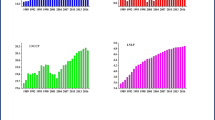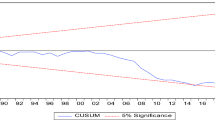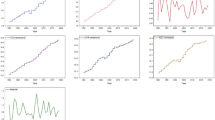Abstract
In this paper, the relationship between carbon dioxide and agriculture in Ghana was investigated by comparing a Vector Error Correction Model (VECM) and Autoregressive Distributed Lag (ARDL) Model. Ten study variables spanning from 1961 to 2012 were employed from the Food Agricultural Organization. Results from the study show that carbon dioxide emissions affect the percentage annual change of agricultural area, coarse grain production, cocoa bean production, fruit production, vegetable production, and the total livestock per hectare of the agricultural area. The vector error correction model and the autoregressive distributed lag model show evidence of a causal relationship between carbon dioxide emissions and agriculture; however, the relationship decreases periodically which may die over-time. All the endogenous variables except total primary vegetable production lead to carbon dioxide emissions, which may be due to poor agricultural practices to meet the growing food demand in Ghana. The autoregressive distributed lag bounds test shows evidence of a long-run equilibrium relationship between the percentage annual change of agricultural area, cocoa bean production, total livestock per hectare of agricultural area, total pulses production, total primary vegetable production, and carbon dioxide emissions. It is important to end hunger and ensure people have access to safe and nutritious food, especially the poor, orphans, pregnant women, and children under-5 years in order to reduce maternal and infant mortalities. Nevertheless, it is also important that the Government of Ghana institutes agricultural policies that focus on promoting a sustainable agriculture using environmental friendly agricultural practices. The study recommends an integration of climate change measures into Ghana’s national strategies, policies and planning in order to strengthen the country’s effort to achieving a sustainable environment.






Similar content being viewed by others
Abbreviations
- AIC:
-
Akaike Information Criterion
- ARDL:
-
Autoregressive Distributed Lag
- CHAL:
-
% annual change (Agricultural area)
- COAGRAPROD:
-
Coarse Grain, Production (Tons)
- COCOBE:
-
Cocoa, beans Production (Tonnes)
- FPE:
-
Final Prediction Error
- FRUPROD:
-
Fruit excl Melons, Production (Tons)
- HQ:
-
Hannan-Quinn Information Criteria
- LIVEHEC:
-
Livestock total per hectare of agricultural area (No/Ha)
- LR:
-
Sequential Likelihood-Ratio
- MDGs:
-
Millennium Development Goals
- PULPROD:
-
Total Pulses Production
- RNTPROD:
-
Roots and Tubers, Total Production (Tons)
- SC:
-
Schwarz Information Criterion
- SDG:
-
Sustainable Development Goal
- VAR:
-
Vector Autoregression
- VECM:
-
Vector Error Correction Model
- VEGPROD:
-
Vegetable Production (Tons)
- Chi2:
-
Chi square
- Coef.:
-
Coefficient
- cointEq:
-
Cointegrated equation
- df:
-
Difference
- Prob:
-
Probability
- Std. Err.:
-
Standard error
- π:
-
Rank
References
Adom PK, Bekoe W (2012) Conditional dynamic forecast of electrical energy consumption requirements in Ghana by 2020: a comparison of ARDL and PAM. Energy 44:367–380
Asumadu-Sarkodie S, Owusu PA (2015) Media impact on students’ body image. Int J Res Appl Sci Eng Technol 3:460–469
Asumadu-Sarkodie S, Owusu P (2016a) Feasibility of biomass heating system in Middle East Technical University, Northern Cyprus campus cogent engineering doi:10.1080/23311916.2015.1134304
Asumadu-Sarkodie S, Owusu PA (2016b). The potential and economic viability of solar photovoltaic in Ghana. Energy Sources, Part A: Recovery, Utilization, and Environmental Effects. doi:10.1080/15567036.2015.1122682
Asumadu-Sarkodie S, Owusu PA (2016c). The potential and economic viability of wind farm in Ghana. Energy Sources, Part A: Recovery, Utilization, and Environmental Effects. doi:10.1080/15567036.2015.1122680
Asumadu-Sarkodie, S., & Owusu, P. A. (2016d). Multivariate Co-integration Analysis of the Kaya Factors In Ghana. Environmental Science and Pollution Research. doi:10.1007/s11356-016-6245-9
Asumadu-Sarkodie S, Owusu PA, Jayaweera HM (2015a) Flood risk management in Ghana: a case study in Accra. Adv Appl Sci Res 6:196–201
Asumadu-Sarkodie S, Owusu PA, Rufangura P (2015b) Impact analysis of flood in Accra, Ghana. Adv Appl Sci Res 6:53–78
Bakhtiari AA, Hematian A, Sharifi A (2015) Energy analyses and greenhouse gas emissions assessment for saffron production cycle. Environ Sci Pollut Res Int 22:16184–16201. doi:10.1007/s11356-015-4843-6
Borah L, Baruah KK (2015) Nitrous oxide emission and mitigation from wheat agriculture: association of physiological and anatomical characteristics of wheat genotypes. Environ Sci Pollut Res Int. doi:10.1007/s11356-015-5299-4
Breitung J (1999) The local power of some unit root tests for panel data. Discussion papers, interdisciplinary research project 373: quantification and simulation of economic processes
Brown RL, Durbin J, Evans JM (1975) Techniques for testing the constancy of regression relationships over time. J R Stat Soc Ser B (Methodol):149–192
Burney JA, Davis SJ, Lobell DB (2010) Greenhouse gas mitigation by agricultural intensification. Proc Natl Acad Sci 107:12052–12057
Busch J et al (2012) Structuring economic incentives to reduce emissions from deforestation within Indonesia. Proc Natl Acad Sci U S A 109:1062–1067
Chang C-C (2010) A multivariate causality test of carbon dioxide emissions, energy consumption and economic growth in China. Appl Energy 87:3533–3537
Chang SJ (2013) Solving the problem of carbon dioxide emissions. For Policy Econ 35:92–97. doi:10.1016/j.forpol.2013.06.013
Choi I (2001) Unit root tests for panel data. J Int Money Financ 20:249–272
Earth System Research Laboratory (2015) The NOAA Annual Greenhouse Gas Index (AGGI). http://www.esrl.noaa.gov/gmd/aggi/aggi.html. Accessed Oct 24, 2015
Engle RF, Granger CW (1987) Co-integration and error correction: representation, estimation, and testing Econometrica: J Econ Soci 251–276
Farhani S, Ozturk I (2015) Causal relationship between CO2 emissions, real GDP, energy consumption, financial development, trade openness, and urbanization in Tunisia. Environ Sci Pollut Res Int 22:15663–15676. doi:10.1007/s11356-015-4767-1
Fei L, Dong S, Xue L, Liang Q, Yang W (2011) Energy consumption-economic growth relationship and carbon dioxide emissions in China. Energ Policy 39:568–574. doi:10.1016/j.enpol.2010.10.025
Food Agriculture Organization FAO Statistical Yearbooks—World food and agriculture. http://faostat3.fao.org/home/E
Fuinhas JA, Marques AC (2012) Energy consumption and economic growth nexus in Portugal, Italy, Greece, Spain and Turkey: an ARDL bounds test approach (1965–2009). Energy Econ 34:511–517. doi:10.1016/j.eneco.2011.10.003
Granger CW (1988) Some recent development in a concept of causality. J Econ 39:199–211
Gul S, Zou X, Hassan CH, Azam M, Zaman K (2015) Causal nexus between energy consumption and carbon dioxide emission for Malaysia using maximum entropy bootstrap approach. Environ Sci Pollut Res 1–13
Hadri K (2000) Testing for stationarity in heterogeneous panel data. Econ J 148–161
Hagemann M, Ndambi A, Hemme T, Latacz-Lohmann U (2012) Contribution of milk production to global greenhouse gas emissions. An estimation based on typical farms. Environ Sci Pollut Res Int 19:390–402. doi:10.1007/s11356-011-0571-8
Huang B-N, Hwang MJ, Yang CW (2008) Causal relationship between energy consumption and GDP growth revisited: a dynamic panel data approach. Ecol Econ 67:41–54. doi:10.1016/j.ecolecon.2007.11.006
Hussain S, Peng S, Fahad S, Khaliq A, Huang J, Cui K, Nie L (2015) Rice management interventions to mitigate greenhouse gas emissions: a review. Environ Sci Pollut Res Int 22:3342–3360. doi:10.1007/s11356-014-3760-4
Im KS, Pesaran MH, Shin Y (2003) Testing for unit roots in heterogeneous panels. J Econ 115:53–74
Johansen S (1995) Likelihood-based inference in cointegrated vector autoregressive models OUP catalogue
Kankal M, Akpınar A, Kömürcü Mİ, Özşahin TŞ (2011) Modeling and forecasting of Turkey’s energy consumption using socio-economic and demographic variables. Appl Energy 88:1927–1939. doi:10.1016/j.apenergy.2010.12.005
Levin A, Lin C-F, Chu C-SJ (2002) Unit root tests in panel data: asymptotic and finite-sample properties. J Econ 108:1–24
Li W, Ou Q, Chen Y (2014) Decomposition of China’s CO2 emissions from agriculture utilizing an improved Kaya identity. Environ Sci Pollut Res Int 21:13000–13006. doi:10.1007/s11356-014-3250-8
Liu W et al (2015) Greenhouse gas emissions, soil quality, and crop productivity from a mono-rice cultivation system as influenced by fallow season straw management. Environ Sci Pollut Res Int
Lozano S, Gutiérrez E (2008) Non-parametric frontier approach to modelling the relationships among population, GDP, energy consumption and CO2 emissions. Ecol Econ 66:687–699. doi:10.1016/j.ecolecon.2007.11.003
Maddala GS, Wu S (1999) A comparative study of unit root tests with panel data and a new simple test. Oxf Bull Econ Stat 61:631–652
Mahadeva L, Robinson P (2004) Unit root testing to help model building
Ministry of Food and Agriculture Agriculture in Ghana, Facts and Figures
Ozturk I, Acaravci A (2011) Electricity consumption and real GDP causality nexus: evidence from ARDL bounds testing approach for 11 MENA countries. Appl Energy 88:2885–2892
Pesaran MH, Shin Y (1998) An autoregressive distributed-lag modelling approach to cointegration analysis. Econ Soc Monogr 31:371–413
Pesaran MH, Shin Y, Smith RJ (2001) Bounds testing approaches to the analysis of level relationships. J Appl Econ 16:289–326
Roth E et al (2014) Impact of raw pig slurry and pig farming practices on physicochemical parameters and on atmospheric N2O and CH4 emissions of tropical soils, Uvea Island (South Pacific). Environ Sci Pollut Res Int 21:10022–10035. doi:10.1007/s11356-014-3048-8
Soytas U, Sari R (2009) Energy consumption, economic growth, and carbon emissions: challenges faced by an EU candidate member. Ecol Econ 68:1667–1675. doi:10.1016/j.ecolecon.2007.06.014
Tilman D, Cassman KG, Matson PA, Naylor R, Polasky S (2002) Agricultural sustainability and intensive production practices. Nature 418:671–677
UNTC United Nations Treaty Collection https://treaties.un.org/. Accessed 14 Nov 2015
Zhang X-P, Cheng X-M (2009) Energy consumption, carbon emissions, and economic growth in China. Ecol Econ 68:2706–2712. doi:10.1016/j.ecolecon.2009.05.011
Author information
Authors and Affiliations
Corresponding author
Additional information
Responsible editor: Marcus Schulz
Rights and permissions
About this article
Cite this article
Asumadu-Sarkodie, S., Owusu, P.A. The relationship between carbon dioxide and agriculture in Ghana: a comparison of VECM and ARDL model. Environ Sci Pollut Res 23, 10968–10982 (2016). https://doi.org/10.1007/s11356-016-6252-x
Received:
Accepted:
Published:
Issue Date:
DOI: https://doi.org/10.1007/s11356-016-6252-x




